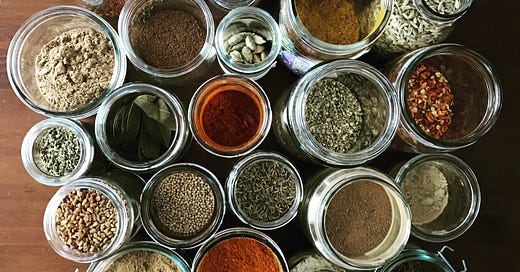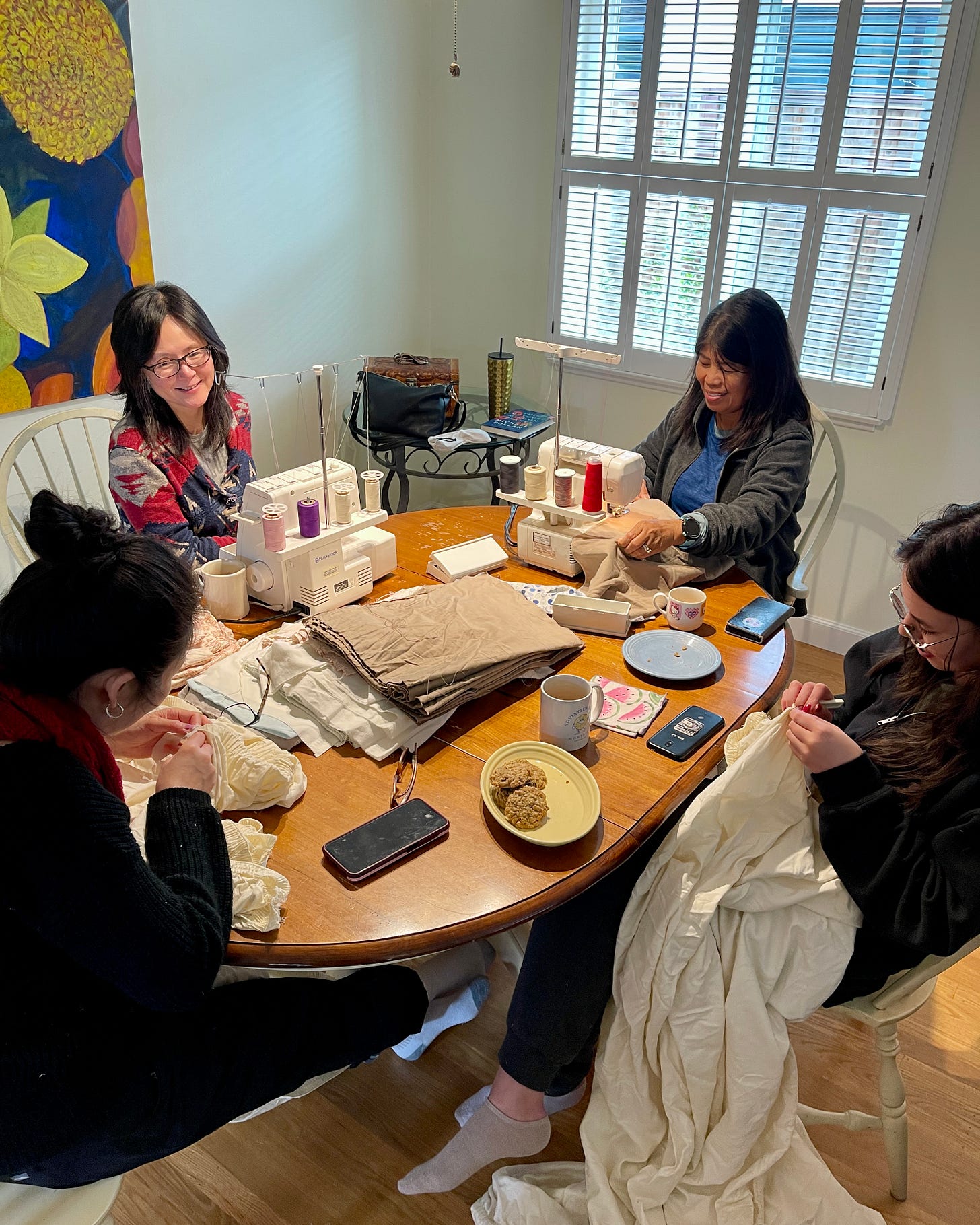My blog turns 11 years old this month. Actually, I fell down the zero-waste rabbit hole back in 2011, when my daughter MK and I decided to break up with plastic. (This was well before researchers had discovered the rapidly rising levels of microplastics in our brains.) MK launched a blog (she was 16), later had trouble keeping it up in university and when I asked if I could take it over, said “No, start your own blog!” So I did in 2014.
Over the years, the following 11 tactics have made the biggest impact in my home.
1. Buy less stuff
If you’re in a hurry, you can skip the rest of the newsletter (but I hope you won’t!).
Buying less stuff simplifies my life, saves money and keeps thneeds out of the landfill. When I want something, I take a look around my home and get creative. Often, I already have what I need.
Many years ago, after harvesting several pounds of cherries from the tree I planted when she was little, MK bought a flimsy looking cherry pitter that would have soon broken. While she returned it to the store, I searched online for homemade cherry pitters. I found this video and before she came home with her refund, I had made a pitter out of an inexpensive fork.
2. Shop at home first
When most of us learned how to cook—and many people were never taught this crucial life skill—the instructions likely went something like this:
Look for a tasty recipe.
Write down the list of ingredients you’ll need.
Schlep to the store, shop for all the food and bring it home.
Prep the ingredients.
Cook the dish.
Put the leftover ingredients in the refrigerator along with any leftovers remaining after the meal.
Return to step 1 and repeat.
This leads to tons of food going uneaten.
To slash wasted food and save money, shop at home first. Quickly look through the refrigerator and freezer to see what perishables need to be eaten, then check the cupboards for staples. What you find will determine what you’ll cook next. If you need one or two ingredients to cook the dish—but you may find a substitute—only then go shopping for more food.
Cooking this way keeps our grocery bills down because we eat all the food we buy. It has also made me a much more creative cook. (I basically play Chopped, Home Edition.) Of course, you can still eat your favorite dishes! But you might not want to do that on a whim when you don’t have any of the ingredients on hand to make them.
This step alone can save your household hundreds of dollars per person every year. In 2023, the average American spent $782 dollars on food they didn’t eat. When food goes to a landfill, where it becomes compacted and deprived of oxygen, anaerobic bacteria break the food down, emitting methane, a greenhouse gas much more potent than carbon dioxide. (Go here for more ideas to reduce wasted food.)
3. Cut ultra-processed foods (UPFs)
While a noble quest, I didn’t set out to cut ultra-processed foods. But because almost all ultra-processed foods come in plastic packages and I had broken up with plastic, I stopped eating UPFs. My diet isn’t perfect—I do bake a lot—but it immediately improved. I eat more fruit and vegetables than I used to. If I want a snack, I’ll eat an apple or orange instead of reaching into the cupboard for a bag of sweets or some other kind of junky food.
4. Shop at farmers’ markets
I’m very fortunate/spoiled to live in Northern California, where multiple farmers’ markets run year-round. Almost all of the fabulous produce sits loose in bins and I bring it home in reusable cloth produce bags. This alone slashed the amount of plastic pollution inflitrating our home.
Some of the food does cost more than what a discount grocery store carries but overall, my lifestyle saves money. I don’t waste food, I don’t buy things I don’t need and when I do want something, I try to find it secondhand. Those three practices save thousands of dollars every year and more than cover the price of incredible local produce. And with no middleman, the farmers also earn more money—90 cents of every dollar we spend directly with them stays in their pockets.
5. Bring your own containers
Some stores allow you to bring containers to fill with bulk foods or bulk cleaning supplies or cheese from the deli counter. Not sure if your store does? Ask!
Be sure to get the weight of your containers before you fill them up. At some stores, customer service will weigh them for you and mark the tare (i.e., weight) on them. Other stores set out scales and you weigh the jars yourself. When you check out, the cashier will deduct the tare from the weight of the filled jar so you pay for the food only.
6. Start with the easy stuff
At events, when I talk about reducing plastic pollution, people occasionally ask what they should do about their meds that come in plastic vials. While continuing to take your meds, focus on the easy stuff. We are swimming upstream in a culture and economy based on consumption and convenience. It’s impossible to be perfect. So start with something you can easily ditch, like plastic water bottles (up to 240,000 pieces of micro- and nanoplastic particles per liter!).
7. Make a plan
Soon after setting out on my quest, I realized that I’d need to plan ahead for certain foods and events. I make my own sour cream but it does take 24 hours to ferment. So if I run out and need it, I wait. Same with my wine vinegar. It takes about a month to brew; when I get low, I start a new batch. By the way, that sour cream and wine vinegar—even made with inexpensive, not great wine—both taste amazing.
Similarly, when the holidays rolled around that first year of our plastic fast, I had to think ahead. Most of the changes were easy: wrapping gifts in reusables or giving experiences as gifts, making ornaments, burying the tree in a raised bed after the holidays (read about hügelkultur here). Ditto for travel; plan ahead and bring your reusables.
8. Show, don’t tell
If you preach, drone on about the depressing statistics on plastic pollution or berate your family, friends and coworkers for their supposed plastic “sins,” no one will listen to you. People dislike being told what to do. Even if you’re right. Even if they know you’re right.
I’ve found that by just doing my own thing, people ask questions and they often make changes. Back in 2011, when I still worked in an office, my boss started buying milk in returnable glass bottles and always saved her lunchtime compost for me, another coworker stopped using plastic baggies in her son’s lunches and another threw her son a plastic-free birthday party. Together, ripples become waves!
9. Enjoy the journey
Personally, I find this lifestyle so much fun. Otherwise, I wouldn’t do it. I eat tastier food, I save money, I enjoy mending stuff (such a feeling of satisfaction!), I’m more self-sufficient than I used to be. And I’ve met the nicest people! Reducing waste should not feel like torture. Do the parts you like.
10. Start small
Don’t attempt to go plastic-free or zero-waste all at once. If you try to rid your life of plastic overnight, you’ll set yourself up for failure. The stuff is everywhere. You’ll need some time to figure out a new routine and time to adjust to it—where to shop, what to buy, what to eat, where to find bathroom tissue not wrapped in plastic and so on. Take one step at a time.
When we first started down this path, we began shopping at the farmers’ market with our homemade reusable produce bags. Next, we found out we could buy food in our own jars at the bulk bins. Eventually, my daughter came up with a good plastic-free replacement for deodorant. Each minor adjustment took time to figure out.
11. Recognize we can do only so much but what we do matters
No single individual can fix the environmental crises the world faces. But millions and millions of us are doing what we can and that makes a difference. (Also, taking action inoculates against depair.)
“I like to envision the whole world as a jigsaw puzzle... If you look at the whole picture, it is overwhelming and terrifying, but if you work on your little part of the jigsaw and know that people all over the world are working on their little bits, that's what will give you hope.”
What I’m reading
I couldn’t put down The Comfort of Crows by Margaret Renkl. With 52 brilliant essays, Renkl chronicles the plants and animals (and her changing life as well) throughout the seasons in her backyard in Tennessee. This book is beautiful and sometimes heartbreaking but, ultimately inspiring and hopeful. It also features the lovely artwork of the author’s brother, Billy Renkl.
Renkl ends the book with a call to action: "The very least I owe my wild neighbors is a willingness to witness their struggle, to compensate for their losses in every way I can, and to speak on their behalf about all the ways I can't. It is my dearest hope that you will do the same for your own wild neighbors."
Upcoming in-person events in California
March 29th, 2pm–3:30pm: Redwood City Library, fermentation demo. Go here for more information.
April 13th: Costa Mesa Donald Dungan Library, talk and cooking demo. More info to come.









Congatulations with eleven years of given inspiration, worldwide. And thank you for that!
For next year, when your blog turns 12, may I add one of my favourite low waste actions? Learn to mend your clothes, know how to repair holes in your socks and sweaters, use beautiful buttons and pieces of material to personalise your wardrobe. It saves lots of money, plus you will have your own unique, creative wardrobe style.
If in doubt and if available you may like to visit a repair café where they will lovingly teach you how to repair your things, not just textiles. I am one of the volunteers in Groningen, the Netherlands. There are many repair café's worldwide, have a look at https://www.repaircafe.org/en/new-worldwide-website-for-repair-cafe/
Wow Ann, Congratulations for completing 11 years of hard work and sharing green ideas!!
:)